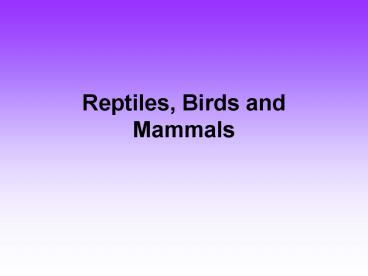Reptiles, Birds and Mammals - PowerPoint PPT Presentation
1 / 14
Title:
Reptiles, Birds and Mammals
Description:
Most use claws to dig, climb and run. ... ( crocs have a 4-chambered heart) Internal fertilization. Tough, leathery amniotic eggs ... – PowerPoint PPT presentation
Number of Views:228
Avg rating:3.0/5.0
Title: Reptiles, Birds and Mammals
1
Reptiles, Birds and Mammals
2
Characteristics of Reptiles
- Ectothermic vertebrate with thick, dry,
waterproof skin. - Most use claws to dig, climb and run.
- Scales prevent the exchange of O2 and CO2 use
lungs to breathe. - Most have a 3-chambered heart. (crocs have a
4-chambered heart) - Internal fertilization
- Tough, leathery amniotic eggs
- Live on every continent except Antarctica.
3
Types of Modern Reptiles
4
Turtles
- Turtles are the only reptiles that have a
two-part shell made of hard, bony plates. The
vertebrae and ribs are fused to the inside of the
top part of the shell.
5
Lizards and Snakes
- Lizards have movable eyelids, snakes do not.
6
Crocodilians
A
B
7
Characteristics of Birds
- Have an almost hollow, but strong endoskeleton.
- Endothermic vertebrate
- Contour feathers give a bird shape and help it to
steer, - Down feathers help birds to maintain their body
temperature. - Preens feathers with an oil that is released from
the base of its tail. - Have a 4-chambered heart.
- Have lungs that connect to balloon-air sacs
- Digestive system includes a crop and gizzard.
8
(No Transcript)
9
Characteristics of Mammals
- Endothermic vertebrate
- Have hair
- Have mammary glands that produce milk
- Care for their young
- Have a 4-chambered heart
- Digestive systems vary according to the type of
food they eat.
10
Types of Mammals
11
Monotremes
- Mammals that lay eggs, like the duck-billed
platypus.
12
Marsupials
- Give birth to immature young that usually crawl
into an external pouch or latches to the females
nipple until fully developed.
13
Placentals
- Embryos completely develop inside females
uterus. - An organ called a placenta works with an
umbilical chord to provide embryo with food and
oxygen.
14
Aquatic Placentals































